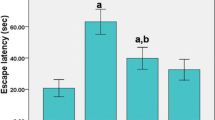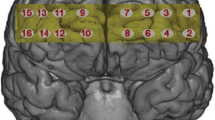Abstract
Objective
Ecstasy can damage the hippocampus, which impairs memory and learning. Using anti-inflammatory compounds such as curcumin may improve the side effects of ecstasy. In this study, we investigated the effect of curcumin on spatial learning and expression of NF-kB and GFAP genes in the hippocampus of rats.
Methods
Male Wistar rats were divided into five groups: (1) control, (2) sham receiving saline, (3) sham receiving DMSO, (4) received ecstasy (15 mg/kg dose twice daily for four days), and (5) ecstasy receiving curcumin (200 mg/kg daily for one week). Spatial memory was estimated by Morris water maze, and GFAP and NF-kB levels in the hippocampus were assessed by qRT-PCR.
Results
Morris water maze results showed that the time spent finding the platform in the ecstasy group increased compared to the control (p < 0.001), while this time decreased in the ecstasy-curcumin group compared to the ecstasy group (p < 0.01). QRT-PCR results showed that the expression of GFAP and NF-kB is increased in the ecstasy group compared to the controls (p < 0.01). Curcumin increased the expression level of the NF-kB gene (p < 0.001), while the expression level of GFAP decreased and approached the level of the control group.
Conclusions
This study showed that ecstasy exposure leads to memory impairment. Co-administration of curcumin provided partial protection against memory impairment caused by ecstasy. It seems that the increase in NF-kB in the hippocampus following the administration of curcumin is a sign of cell regeneration and preserves cell life.





Similar content being viewed by others
References
Fuentealba Y, Valdés JL (2019) The role of hippocampus during observational learning. bioRxiv 832758
Wenger E, Lövdén M (2016) The learning hippocampus: Education and experience-dependent plasticity. Mind Brain Educ 10(3):171–183
Bellander M et al (2016) Behavioral correlates of changes in hippocampal gray matter structure during acquisition of foreign vocabulary. Neuroimage 131:205–213
Bernschneider-Reif S, Öxler F, Freudenmann R (2006) The origin of MDMA (‘ecstasy’)–separating the facts from the myth. Die Pharmazie-Int J Pharm Sci 61(11):966–972
Green AR et al (2003) The pharmacology and clinical pharmacology of 3, 4-methylenedioxymethamphetamine (MDMA, “ecstasy”). Pharmacol Rev 55(3):463–508
Ma Y et al (2020) 3, 4-Methylenedioxymethamphetamine causes retinal damage in C57BL/6J mice. Hum Exp Toxicol 39(11):1556–1564
Parrott AC (2013) Human psychobiology of MDMA or ‘Ecstasy’: an overview of 25 years of empirical research. Hum Psychopharmacol Clin Exp 28(4):289–307
Nazari Z, Bahrehbar K, Golalipour MJ (2022) Effect of MDMA exposure during pregnancy on cell apoptosis, astroglia, and microglia activity in rat offspring striatum. Iran J Basic Med Sci 25(9):1
Hall A, Henry J (2006) Acute toxic effects of ‘Ecstasy’(MDMA) and related compounds: overview of pathophysiology and clinical management. BJA Br J Anaesth 96(6):678–685
Farre M et al (2004) Repeated doses administration of MDMA in humans: pharmacological effects and pharmacokinetics. Psychopharmacology 173(3):364–375
Jurga AM et al (2021) Beyond the GFAP-astrocyte protein markers in the brain. Biomolecules 11(9):1361
Zhang Z et al (2019) The appropriate marker for astrocytes: comparing the distribution and expression of three astrocytic markers in different mouse cerebral regions. BioMed Res Int 2019:1
Rosa J-G et al (2022) Spatial and temporal diversity of astrocyte phenotypes in spinocerebellar ataxia type 1 mice. Cells 11(20):3323
Mostafizar M et al (2021) Challenges with methods for detecting and studying the transcription factor nuclear factor kappa B (NF-κB) in the central nervous system. Cells 10(6):1335
Dresselhaus EC, Meffert MK (2019) Cellular specificity of NF-κB function in the nervous system. Front Immunol 10:1043
Tiangco DA et al (2010) 3, 4-Methylenedioxymethamphetamine alters left ventricular function and activates nuclear factor-Kappa B (NF-κB) in a time and dose dependent manner. Int J Mol Sci 11(12):4843–4863
Aguirre N et al (1999) α-Lipoic acid prevents 3, 4-methylenedioxy-methamphetamine (MDMA)-induced neurotoxicity. NeuroReport 10(17):3675–3680
Nabiuni M et al (2013) Curcumin downregulates aquaporin-1 expression in cultured rat choroid plexus cells. J Med Food 16(6):504–510
Hussain Z et al (2017) Exploring recent developments to improve antioxidant, anti-inflammatory and antimicrobial efficacy of curcumin: a review of new trends and future perspectives. Mater Sci Eng, C 77:1316–1326
Dolatabadi LK et al (2019) Curcumin effects on memory impairment and restoration of irregular neuronal distribution in the hippocampal CA1 region after global cerebral ischemia in male rats. Basic Clin Neurosci 10(5):527
Nabiuni M et al (2011) Neuroprotective effects of curcumin
Saikia AP et al (2006) Ethnobotany of medicinal plants used by Assamese people for various skin ailments and cosmetics. J Ethnopharmacol 106(2):149–157
Shih J-H et al (2019) Autophagy inhibition plays a protective role against 3, 4-methylenedioxymethamphetamine (MDMA)-induced loss of serotonin transporters and depressive-like behaviors in rats. Pharmacol Res 142:283–293
Kermanian F et al (2012) The role of adenosine receptor agonist and antagonist on Hippocampal MDMA detrimental effects; a structural and behavioral study. Metab Brain Dis 27(4):459–469
Boarescu I et al (2022) Anti-inflammatory and analgesic effects of curcumin nanoparticles associated with diclofenac sodium in experimental acute inflammation. Int J Mol Sci 23(19):11737
Kermani ES et al (2018) Gestational diabetes influences the expression of hypertrophic genes in left ventricle of rat’s offspring. Iran J Basic Med Sci 21(5):525
Bahrehbar K et al (2022) Embryonic stem cells-derived mesenchymal stem cells do not differentiate into ovarian cells but improve ovarian function in POF mice. Biochem Biophys Res Commun 635:92–98
Budzynska B et al (2017) Acute behavioral effects of co-administration of mephedrone and MDMA in mice. Pharmacol Rep 69(2):199–205
Capela JP et al (2009) Molecular and cellular mechanisms of ecstasy-induced neurotoxicity: an overview. Mol Neurobiol 39(3):210–271
Baumann MH, Wang X, Rothman RB (2007) 3, 4-Methylenedioxymethamphetamine (MDMA) neurotoxicity in rats: a reappraisal of past and present findings. Psychopharmacology 189(4):407–424
Kermanian F et al (2014) Effects of adenosine A2a receptor agonist and antagonist on cerebellar nuclear factor-kB expression preceded by MDMA toxicity. Med J Islam Repub Iran 28:120
Montiel-Duarte C et al (2004) Role of reactive oxygen species, glutathione and NF-κB in apoptosis induced by 3, 4-methylenedioxymethamphetamine (“Ecstasy”) on hepatic stellate cells. Biochem Pharmacol 67(6):1025–1033
Jahanshahi M et al (2013) Effects of repeated administration of 3, 4-methylenedioxymethamphetamine (MDMA) on avoidance memory and cell density in rats’ hippocampus. Basic Clin Neurosci 4(1):57
Kelly KA et al (2012) Chronic exposure to corticosterone enhances the neuroinflammatory and neurotoxic responses to methamphetamine. J Neurochem 122(5):995–1009
Kaltschmidt B, Kaltschmidt C (2009) NF-κB in the nervous system. Cold Spring Harb Perspect Biol 1(3):a001271
O’Mahony A et al (2006) NF-κB/Rel regulates inhibitory and excitatory neuronal function and synaptic plasticity. Mol Cell Biol 26(19):7283–7298
Kaltschmidt B, Widera D, Kaltschmidt C (2005) Signaling via NF-κB in the nervous system. Biochimica et Biophysica Acta (BBA)-Molecular Cell Research 1745(3):287–299
Acknowledgements
We acknowledge the Golestan University of Medical Sciences for the financial support of this research (Grant No.: 950124015).
Author information
Authors and Affiliations
Corresponding author
Ethics declarations
Conflict of interest
Zahra Nazari, Khadijeh Bahrehbar, Hamid Sepehri and Mohammad Jafar Golalipou declare that we have no conflict of interest.
Ethical approval
In this study, the ethical committee of the Golestan University of Medical Sciences (Golestan, Iran) approved all animal experiments (Ethical code: IR.GOUMS.REC.1395.32).
Rights and permissions
Springer Nature or its licensor (e.g. a society or other partner) holds exclusive rights to this article under a publishing agreement with the author(s) or other rightsholder(s); author self-archiving of the accepted manuscript version of this article is solely governed by the terms of such publishing agreement and applicable law.
About this article
Cite this article
Nazari, Z., Bahrehbar, K., Sepehri, H. et al. Curcumin can improve ecstasy-induced hippocampal damage in rat. Toxicol. Environ. Health Sci. 15, 173–179 (2023). https://doi.org/10.1007/s13530-023-00170-z
Accepted:
Published:
Issue Date:
DOI: https://doi.org/10.1007/s13530-023-00170-z




